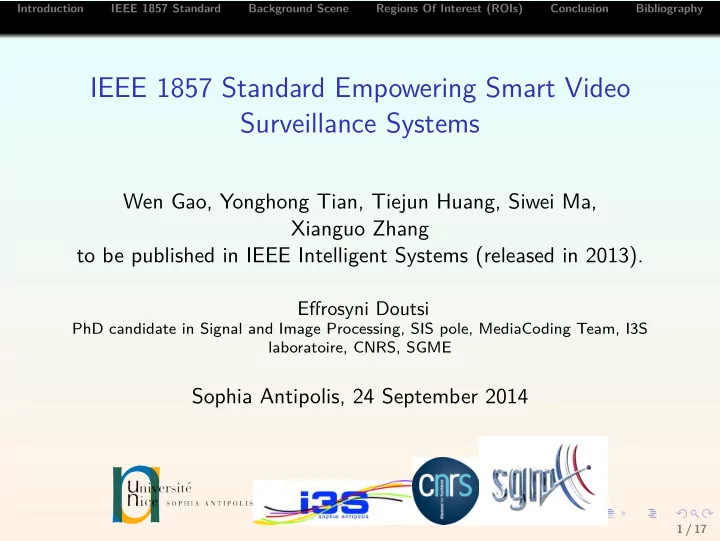

Introduction IEEE 1857 Standard Background Scene Regions Of Interest (ROIs) Conclusion Bibliography IEEE 1857 Standard Empowering Smart Video Surveillance Systems Wen Gao, Yonghong Tian, Tiejun Huang, Siwei Ma, Xianguo Zhang to be published in IEEE Intelligent Systems (released in 2013). Effrosyni Doutsi PhD candidate in Signal and Image Processing, SIS pole, MediaCoding Team, I3S laboratoire, CNRS, SGME Sophia Antipolis, 24 September 2014 1 / 17
Introduction IEEE 1857 Standard Background Scene Regions Of Interest (ROIs) Conclusion Bibliography Outline 1 Introduction 2 IEEE 1857 Standard 3 Background Scene 4 Regions Of Interest (ROIs) 5 Conclusion 6 Bibliography 2 / 17
Introduction IEEE 1857 Standard Background Scene Regions Of Interest (ROIs) Conclusion Bibliography Definition Video Surveillance System also known as Closed-Circuit TeleVision (CCTV), is the use of video cameras to transmit a signal to a specific place, on a limited set of monitors. Figure : The gap between the growth rates of video surveillance data and video compression rate in the recent three decades. 3 / 17
Introduction IEEE 1857 Standard Background Scene Regions Of Interest (ROIs) Conclusion Bibliography Definition of the problem Exponential increase of the amount of video-surveillance data Low growth rate of compression (H.264/AVC, H.265/HEVC) Goal Efficient video COding and DECoding (CODEC) algorithm according to the special constraints of video-surveillance systems and find the tradeoff between: High resolution cameras Bandwidth transmission network Storage capacity Recognition capability Replace H.264/AVC and H.265/HEVC which have been built for broadcasting television 4 / 17
Introduction IEEE 1857 Standard Background Scene Regions Of Interest (ROIs) Conclusion Bibliography Recall CODEC Schema 5 / 17
Introduction IEEE 1857 Standard Background Scene Regions Of Interest (ROIs) Conclusion Bibliography Recall H.264/AVC Encoding Figure : GOP (Group of Pictures) structure for video compression. I-frames (Intra-frames) P-frames (Predictive inter-frames) and B-frames (Bi-predictive inter-frames. 6 / 17
Introduction IEEE 1857 Standard Background Scene Regions Of Interest (ROIs) Conclusion Bibliography Compression Algorithms linked to video analysis Figure : The influence of the Quantization Parameter (QP) in object and face recognition for different resolution videos. (a) SIFT. (b) Object Detection. (c) Face Detection. Result Dilemma: High video compression ratio or high recognition accuracy? 7 / 17
Introduction IEEE 1857 Standard Background Scene Regions Of Interest (ROIs) Conclusion Bibliography Compression Algorithms linked to video analysis Figure : The influence of the Quantization Parameter (QP) in object and face recognition for different resolution videos. (a) SIFT. (b) Object Detection. (c) Face Detection. Result Dilemma: High video compression ratio or high recognition accuracy? 7 / 17
Introduction IEEE 1857 Standard Background Scene Regions Of Interest (ROIs) Conclusion Bibliography Overview: Released in June 2013 Constructed by 6 different groups (Main, Portable, Enhanced, Broadcasting, Surveillance Baseline and Surveillance) Double compression rate comparing to H.264/AVC similar to H.265/HEVC) Almost the same complexity as H.264/AVC High-Efficiency and low-complexity video coding technologies which reduce the scene redundancy ( Background Scene ) Recognition-friendlyness ( Regions Of Interest (ROIs) ) 8 / 17
Introduction IEEE 1857 Standard Background Scene Regions Of Interest (ROIs) Conclusion Bibliography Characteristics: A novel model-based coding framework Low-complexity Background Scene modeling G-pictures background prediction Optional Difference coding for mixed macroblocks (MBs) ( Regions Of Interest (ROIs) ) Improved motion vector prediction Improved BBV buffer management Error-resilience coding tools 9 / 17
Introduction IEEE 1857 Standard Background Scene Regions Of Interest (ROIs) Conclusion Bibliography Reducing scene redundancy Figure : (a) Surveillance video coding with the background model. (b) Ideal bitrate curve. 10 / 17
Introduction IEEE 1857 Standard Background Scene Regions Of Interest (ROIs) Conclusion Bibliography IEEE 1857 vs H.264/AVC Figure : Some dataset examples of different (a) resolution and (b) weather and time conditions. 11 / 17
Introduction IEEE 1857 Standard Background Scene Regions Of Interest (ROIs) Conclusion Bibliography IEEE 1857-S vs H.264/AVC and IEEE 1857-M SD 720p 1600x1200 1080p IEEE 1857 vs H.264-HP 38.9% 61.8% 35.5% 33.0% IEEE 1857 vs IEEE 1857-M 39.6% 60.8% 30.7% 33.1% IEEE 1857-S vs H.264/AVC dawn morning noon afternoon dusk night SD 59.1% 37.5% 26.4% 33.8% 14.2% 15.1% 720p 87.95% 52.80 % 46.60% 46.79% 63.01% 69.75% 1080p - 38.4% 45.4% - 22.6% - Model-based HEVC vs H.264/AVC SD 720p 1600x1200 1080p AVG Bitrate Reduction 45.40% 53.47% 45.43% 39.24% 45.89% Time Saving 49.40% 53.47 % 45.94% 24.68% 45.86% 12 / 17
Introduction IEEE 1857 Standard Background Scene Regions Of Interest (ROIs) Conclusion Bibliography Supporting video analysis and recognition Figure : Some dataset examples of different (a) resolution and (b) weather and time conditions. 13 / 17
Introduction IEEE 1857 Standard Background Scene Regions Of Interest (ROIs) Conclusion Bibliography Supporting video analysis and recognition Apply the background model Detect the ROIs Increase the bit allocation to ROIs Produce the code stream Extract only ROIs to be further analysed Result The Dilemma between High video compression ratio and high recognition accuracy doesn’t exist anymore. 14 / 17
Introduction IEEE 1857 Standard Background Scene Regions Of Interest (ROIs) Conclusion Bibliography Supporting video analysis and recognition Apply the background model Detect the ROIs Increase the bit allocation to ROIs Produce the code stream Extract only ROIs to be further analysed Result The Dilemma between High video compression ratio and high recognition accuracy doesn’t exist anymore. 14 / 17
Introduction IEEE 1857 Standard Background Scene Regions Of Interest (ROIs) Conclusion Bibliography To sum up, IEEE 1857 standard: Is a new compression standard for video surveillance systems Transforms a camera-eye of a scene into an intelligent-camera which is able to remove the scenic redundancy based on the background scene technology Reduces the bitrate compare to H.264/AVC Is recognition-friendly by coding only the ROIs Supports video analysis and recognition 15 / 17
Introduction IEEE 1857 Standard Background Scene Regions Of Interest (ROIs) Conclusion Bibliography Bibliography [ 1 ] WenGao , YonghongTian , TiejunHuang , SiweiMa , Xianguo Zhang, IEEE 1857 Standard Empowering Smart Video Surveillance Systems, to be published in IEEE Intelligent Systems. 16 / 17
Introduction IEEE 1857 Standard Background Scene Regions Of Interest (ROIs) Conclusion Bibliography Thank you for your attention.. 17 / 17
Recommend
More recommend